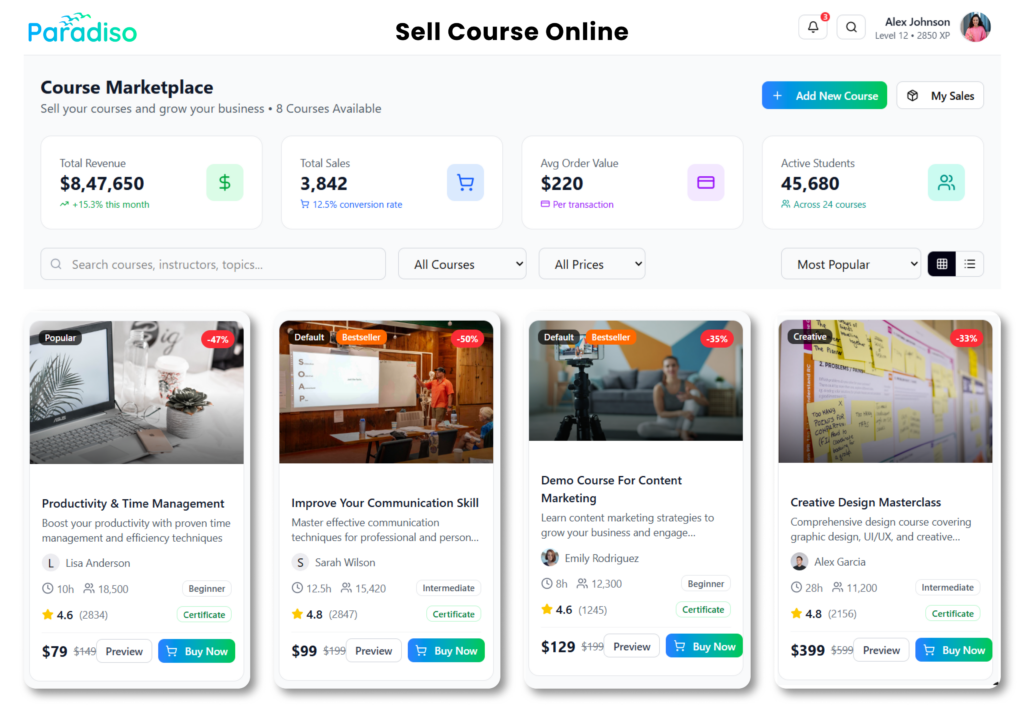Common challenges faced during the online course creation
Challenge 1: How to Structure My Course?
One of the biggest challenges when creating an online course is figuring out how to structure the material. Many course creators struggle with deciding the most effective way to organize their content so that it flows logically and is easy for students to understand. This can include figuring out the best order to present the material, breaking it down into manageable chunks, and identifying what type of activities or assessments to include.
Challenge 2: Will My Course Sell?
Another common challenge is trying to determine whether or not your course will be successful in the marketplace. This can include questions such as: Is there a market for this course? Will the course be appealing to potential students? What are the competition’s courses like? A good approach is doing market research, understanding the target audience, and having a clear value proposition.
Challenge 3: What Marketing and Technology Tools Do I Need to Get Started?
A third challenge many course creators face is figuring out what marketing and technology tools are needed to launch and promote their courses. This can include selecting a learning management system (LMS), choosing the best marketing channels to reach potential students, and figuring out how to use tools such as email marketing, webinars, and social media to promote the course. Learning and using these tools can take time, but once you figure out what works best for you, it can make the promotion process much easier.
Strategies to launch your online course
1. How to Structure My Course?
- Start by creating an outline of the main topics you want to cover.
- Break down the material into smaller sections and organize them logically.
- Identify key learning objectives for each section and ensure they align with your overall course goals.
- Incorporate activities and assessments to keep students engaged, such as quizzes, exercises, and discussions.
- Get feedback from beta testers or other subject matter experts to ensure the content is clear and easy to understand.
- Once you have the course structure in place, test it with a small group of students to get more feedback.
2. Will My Course Sell?
- Conduct market research to understand your target audience, their needs, and pain points
- Identify the competition and understand the gaps in the market
- Get feedback from potential students on the course’s value proposition.
- Create a landing page or website to promote the course and start building an email list
- Utilize social media, webinars, and other marketing tools to reach your target audience
- Implement a pre-launch strategy to create buzz and excitement around the course
3: What Marketing and Technology Tools Do I Need to Get Started?
- Research and evaluate different learning management systems to find the best fit your needs.
- Create a website or landing page to promote your course and start building an email list
- Utilize various marketing channels to reach potential students, such as social media, webinars, email marketing, and paid advertising.
- Use free or low-cost tools to create course and promotional materials.
- Learn and become proficient in the technology and marketing tools you need to use through online tutorials, blogs, or attending webinars.
- Connect with other course creators and join online communities for support and advice.
4: Create a Course One-Pager
A course one-pager is a simple document that outlines the main points of your course, including the course title, a brief description of what the course will cover, the target audience, and any necessary prerequisites. This document can be used to help you stay organized and focused as you plan and create your course, and it can also be used to give potential students an idea of what the course will be about.
5: Record One Piece of Content A Week
Creating course content can be time-consuming, but one way to make it more manageable is to break it up into smaller pieces and record one piece of content per week. This will help you stay on schedule and ensure that you have enough content to fill your course. It’s good to have a regular schedule to keep the momentum going and have the discipline to do so
6: Put Your Content on A Course Platform
Once your course content is recorded, you’ll need to put it on a course platform so your students can access it. Many different course platforms are available, such as Paradiso CourseCart, Udemy, Coursera, and Thinkific, each with its features and pricing plans. Choose the one that fits your need the most. Also, you can use your website and sell your course there too.
7: Create a Compelling Sales Page
A sales page on your website specifically designed to convince potential students to enroll in your course. The page should include:
- A strong headline.
- An overview of the course.
- Testimonials from past students.
- A clear call to action.
Additionally, it’s good to have a video trailer of your course to better understand what’s inside.
8: Market Your Course
Once you have your course created and your sales page ready, it’s time to start marketing your course. There are many different ways to promote your course, including:
- Social media marketing
- Influencer marketing
- Content marketing
- Email marketing
- Paid advertising
- Promotion through related communities and groups













